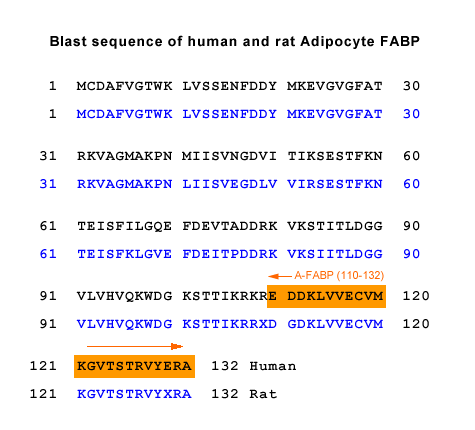Catalog # |
Size |
Price |
|
|---|---|---|---|
| FR-G-006-12 | 100 µl | $629 |

BACKGROUND: Adipocyte-fatty acid binding protein (A-FABP), a major cytoplasmic protein in adipocytes, plays a central role in the development of diabetes and atherosclerotic cardiovascular disease in experimental animals. We have previously shown that A-FABP is present in the bloodstream and that its circulating levels correlate with metabolic risk factors in a cross-sectional study. In the present study, we further evaluated the prospective association of A-FABP with the metabolic syndrome (MetS) as defined by the updated National Cholesterol Education Program criteria.METHODS AND RESULTS: In the present study, 495 nondiabetic adults from the population-based Hong Kong Cardiovascular Risk Factor Prevalence Study were prospectively followed up for 5 years. The relationship of serum A-FABP with the MetS and its components was investigated. At baseline, high A-FABP levels were associated with the MetS (odds ratio, 4.0; 95% CI, 1.5 to 10.4; highest versus lowest sex-specific tertile, adjusted for age, body mass index, the homeostasis model assessment index for insulin resistance, C-reactive protein, and adiponectin, P=0.005). On long-term follow-up, subjects with higher baseline A-FABP levels had progressively worse cardiometabolic risk profile and increasing risk of the MetS. Among 376 subjects without the MetS at baseline, 50 had developed it at 5 years. Apart from the homeostasis model assessment index for insulin resistance (P=0.001), baseline A-FABP was the only independent predictor of the development of the MetS during the 5-year follow-up (odds ratio, 4.7; 95% CI, 1.8 to 11.9; highest versus lowest sex-specific tertile, P=0.001, adjusted for the homeostasis model assessment index for insulin resistance and body mass index). A-FABP was predictive of the MetS even after adjustment for each of its individual components.CONCLUSIONS: Circulating A-FABP predicts the development of the MetS independently of adiposity and insulin resistance.
AIM: Plasma adipocyte fatty acid binding protein (A-FABP) and epidermal fatty acid binding protein (E-FABP) concentrations have been linked to obesity and the metabolic syndrome. In this study, we investigated whether plasma A-FABP and E-FABP concentrations are altered by weight loss in obese patients.
Methods: In a prospective study, fasting plasma A-FABP and E-FABP concentrations were measured before and 6 months after gastric banding in 33 morbidly obese patients, with a body mass index (BMI) of 46 +/- 5 kg/m(2). Eleven healthy subjects with a BMI < 25 kg/m(2) served as controls.
Results: A-FABP and E-FABP plasma concentrations were higher in obese subjects (36.7 +/- 6.7 and 3.7 +/- 0.7 ng/ml, respectively) than in controls (18.1 +/- 0.6 and 2.6 +/- 0.5, respectively, p < 0.01). Gastric banding reduced BMI to 40 +/- 5 kg/m(2), A-FABP to 32.6 +/- 5.4 ng/ml and E-FABP to 1.9 +/- 0.7 ng/ml (all p < 0.05) after 6 months. Insulin sensitivity as estimated by the Homeostasis Model Assessment insulin resistance index was unchanged. A-FABP concentrations were significantly associated with BMI before and 6 months after surgery (p < 0.05, r = 0.42 and r = 0.37 respectively).
Conclusions: Elevated plasma A-FABP and E-FABP concentrations in morbidly obese subjects are reduced after gastric banding-induced weight loss. This suggests that FABP may be associated with improvement of metabolic conditions over time.
Haider DG, Schindler K, Bohdjalian A, et al. Plasma adipocyte and epidermal fatty acid binding protein is reduced after weight loss in obesity. Diabetes Obes Metab. 2007;9(5):761-3.
No References
| Catalog# | Product | Size | Price | Buy Now |
|---|
Social Network Confirmation